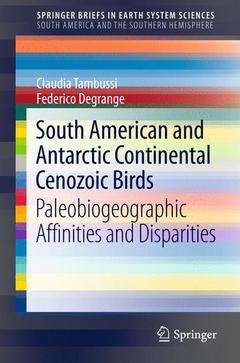South American and Antarctic Continental Cenozoic Birds, 2013 Paleobiogeographic Affinities and Disparities SpringerBriefs in Earth System Sciences Series
Auteurs : Tambussi Claudia P., Degrange Federico

Introduction.- Paleogeograpic background.- Geological settings of the major fossil localities in South America and Antarctica.- The nature of the bird fossil record.- The Paleogene birds of South America.- Eocene birds from Antarctica and their relationships with those of South America.- The Neogene birds of South America.- The dominance of zoophagous birds.- Bioconections of South America and other continents: What is and what is not possible to conclude.
Federico J. Degrange has a License in Biology, with orientation on paleontology, obtained at La Plata University. He is a member of CONICET, and an advanced PhD student in Natural Sciences, working on paleobiology of South American carnivorous birds at La Plata Museum. He is teaching comparative vertebrate anatomy at UNLP. He is (co-)author of seven scientific papers.
Includes supplementary material: sn.pub/extras
Date de parution : 12-2012
Ouvrage de 113 p.
15.5x23.5 cm
Disponible chez l'éditeur (délai d'approvisionnement : 15 jours).
Prix indicatif 52,74 €
Ajouter au panier


